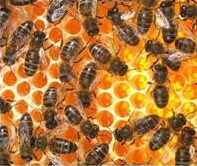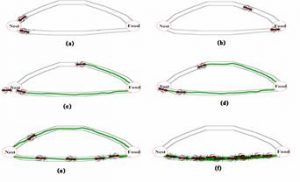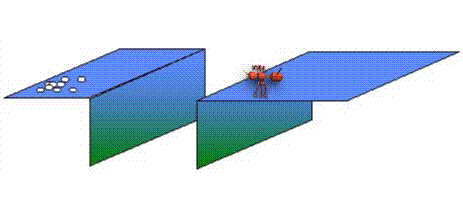Swarm Intelligence
 Swarm Intelligence (SI) is a kind of artificial intelligence that aims to simulate the behavior of swarms of social insects. Swarm refers to any loosely structured collection of interacting agents. Technically swarms are regarded as decentralized self-organized systems. Swarm intelligence has a multidisciplinary character; its study provides insights that can help humans manage complex systems. There is no clear definition for swarm intelligence. Emergent behavior, self-organized behavior and collective intelligence are the related terms. Surprisingly swarm intelligence systems have the ability to act in a coordinated way without any coordinator or external controller.
Swarm Intelligence (SI) is a kind of artificial intelligence that aims to simulate the behavior of swarms of social insects. Swarm refers to any loosely structured collection of interacting agents. Technically swarms are regarded as decentralized self-organized systems. Swarm intelligence has a multidisciplinary character; its study provides insights that can help humans manage complex systems. There is no clear definition for swarm intelligence. Emergent behavior, self-organized behavior and collective intelligence are the related terms. Surprisingly swarm intelligence systems have the ability to act in a coordinated way without any coordinator or external controller.
Ants Invented the Internet?
Click here to learn more about the fascinating similarities between how ants and computers communicate; both filter environmental inputs through algorithms to determine a response, whether that be excreting a particular pheromone, or sending packets of data via TCP/IP.
Swarm Intelligence of Ants
Collective intelligence is the key. A single ant, for example, is not that smart but a colony of ants is. As colonies, ants respond quickly and effectively to their environment. They find the shortest path to the best food source, allocate workers to different tasks, and defend their territory from enemies. Ant colonies make these possible by countless interactions between individual ants. Each ant follows a simple rule of thumb. Each ant acts only on local information. A system that exhibits this behavior is said to be self-organizing. And the intelligence the ants exhibit collectively is called swarm intelligence.



There are four principles governing the swarm intelligence. These are:
- Positive Feedback – reinforces good solutions present in the system
- Negative Feedback – removes old or poor solutions
- Randomness – so solutions can be tested regardless of perceived quality, which in turn, result in creative and unconventional solutions
- Multiple Interactions – key to building up the best solutions
By understanding these properties and applying them correctly, swarm intelligent systems may be designed. Each principle plays a clear role in governing the system.
Benefits of Swarm intelligence (SI)
 This technology is a classic example of learning from nature of the variety of the interesting insect or animal behaviors in the nature. A flock of bird’ sweeps across the sky, a group of ants forages for food. A school of fish swims, turns, flees together, etc. This kind of aggregate motion is generally termed as “swarm behavior.” Recently biologists, and computer scientists in the field of “artificial life” have studied how to model biological swarms to understand how “social animals” interact, achieve goals, evolve, learn and solve complex problems.
This technology is a classic example of learning from nature of the variety of the interesting insect or animal behaviors in the nature. A flock of bird’ sweeps across the sky, a group of ants forages for food. A school of fish swims, turns, flees together, etc. This kind of aggregate motion is generally termed as “swarm behavior.” Recently biologists, and computer scientists in the field of “artificial life” have studied how to model biological swarms to understand how “social animals” interact, achieve goals, evolve, learn and solve complex problems.
Bluetronix technology is grounded in the field of artificial intelligence and, in particular, SWARM Intelligence (a form of AI computing), the next generation of technologies modeled after the behavior of decentralized biological systems, such as insects. SWARM Intelligence (SI) utilizes certain systems in nature, such as ants in colonies, to harness collective intelligence that leverages the simple independent intelligence of its numerous agents into goal oriented systems more efficiently and robustly than conventional centrally-controlled systems.
 Using these AI based swarm intelligence in a vehicle to receive as much information as possible from every other vehicle. This includes route characteristics, traffic conditions and information on the weather. With the aid of this transmitted information, the car can react to the current traffic situation. In this scenario, the more cars there are the greater the information density and the more reliable and better the information is (using swarm intelligence).
Using these AI based swarm intelligence in a vehicle to receive as much information as possible from every other vehicle. This includes route characteristics, traffic conditions and information on the weather. With the aid of this transmitted information, the car can react to the current traffic situation. In this scenario, the more cars there are the greater the information density and the more reliable and better the information is (using swarm intelligence).
Recently the U.S. auto-safety regulators are proposing new rules requiring auto manufactures to adopt crash-avoidance technology that allows all new vehicles to inter-communicate with each other, this will certainly facilitate the development of self-driving cars. The promise of vehicle-to-vehicle communications is clouded by issues regarding current radio-based technology versus future 5G cellular networks.
One example is device-to-device communication. This technology bypasses network infrastructure so that cars and pedestrians’ smartphones can communicate directly to avoid possible accidents.
Swarm Computing… What goes around comes around
The pendulum swings
In the beginning there was the mainframe –highly available, centralised & virtualised computers that could scale to handle multiple workload instances on a timesharing basis. Then we saw the emergence of client server / distributed computing architectures, as business departments and individual users sought to take more control of their compute resources and remove the constraints of using shared resources – computers moved from the datacentre to the server room and the desk. Next came the Cloud – delivering centralised, scalable, shared, virtualised and metered services from large datacentres (sound familiar?). At the same time we see the appearance and rapid evolution of the mobile phone as it becomes the Smartphone and tablet, giving rise to a human-centric mobile computation & communication environment.
 Now, with the increasing computing power of Smartphones and tablets and the advent of the Internet of Things (IoT) with many more connected objects than people on the planet, we see another shift. The location and delivery mechanism of computing and storage power makes another pendulum swing as the total compute capacity “at the edge” overtakes that which is centrally controlled and managed in datacentres. The edges of the Cloud are getting blurred – enter the era of “Fog computing”!
Now, with the increasing computing power of Smartphones and tablets and the advent of the Internet of Things (IoT) with many more connected objects than people on the planet, we see another shift. The location and delivery mechanism of computing and storage power makes another pendulum swing as the total compute capacity “at the edge” overtakes that which is centrally controlled and managed in datacentres. The edges of the Cloud are getting blurred – enter the era of “Fog computing”!
Connected Everything
But there is something of a fundamental difference in this new paradigm. Firstly, the sheer physical number of components comprising the Internet of Everything (IoE: Internet of People + Internet of Things) is predicted to rise at a staggering rate – some estimates suggest up to 50 billion devices by 2025. Secondly, in a lot of cases the individual IoT objects will have somewhat limited compute capabilities and may be producers of apparently mundane data e.g. Smart Thermostat readings. But this individual limited computing capacity will be complimented and supplemented by connection to other objects in a community giving “birth” to the IoT swarm. A co-operative interaction between individual entities – each with their own autonomy, but working together in harmony for the benefit of the collective community and possibly with the potential for interaction with “connected people”.
A Lesson from Nature
To explain further, consider where we see such behavior in nature: Flocks of birds fly in formation for aerodynamic efficiency, greatly increasing possible flying distances; Bees attack in swarms as a means of defence and share intelligence about where to collect pollen; and ants work together in colonies to move objects that would otherwise be impossible.
We already see “swarm” behavior of this type at work in the world of social media:
- Content goes viral as relationship networks are used to cascade information of interest. Things that in isolation would be unlikely to create that much of an impact, suddenly become hot topics.
- Crowd funding can raise $100k’s for individuals in need of costly medical help. The “Swarm” makes possible something that otherwise would not happen.
- Government policies are influenced by the weight of public opinion expressed through social media channels.
Translate this behaviour to the world of connected objects and we see some exciting possibilities:
“Swarms” of driverless cars interact to move safely and efficiently at speeds not possible if controlled in isolation. Vehicles join or leave the swarm as required, contributing their own localised insight to traffic and environmental conditions. Connected soldiers or emergency services personnel share intelligence, access expertise and refine mission parameters without necessarily having to maintain connection back to base. Manufacturing facilities autonomously tune their outputs according to insights gleaned from the connected swarm that reflects the status of a product’s end to end supply chain.
So What for business?
Future business models will be dependent on operational processes that work across the traditional boundaries of organisations, they will need to be adaptive, agile and collaborative. Swarm connections could allow interactions to change according to context, creating dynamic eco-systems of cyber-physical devices, each adding to the collective capability and insight.
We already see smartphone apps that allow Bluetooth meshed networks to establish internet connectivity for devices without direct WiFi connectivity. Smart devices interacting in such a way can bring collective capability to the swarm that might be even greater than the sum of the individual parts. This means that connected objects in the Internet of Things only need to have certain functional capabilities – so long as they are able to join a swarm community that is able to fill the gaps.
Of course there are many considerations that have to be addressed including: determining the legitimacy of an object to join a given swarm; how security and privacy of interactions will be managed; and how to avoid swarm behaviours being used for malicious intent. But could a swarm itself be the means of regulating its behavior through consensus responses? – much like the validation of cryptocurrency public ledgers.
Swarm Intelligent MANETs
The benefits of swarm intelligence can work effectively to resolve current issues in MANETs, or mobile ad-hoc networks. A MANET is a collection of computers, or nodes, participating and cooperating in a computer network. MANETs are increasingly appearing now that wireless devices become more and more ubiquitous. Information is communicated between nodes via a wireless link. There is a limited communications range for each node, and each node has only a few neighbors. Neighbors are nodes that can communicate directly. Nodes are assumed to be mobile; nodes can move relative to each other. Mobility causes the topology of the network to be quite dynamic.

Self-Optimizing Auction Systems
Bluetronix’s new protocols are being developed to account for the dynamic topology of ad-hoc networks, rather than try to adapt old approaches to new problems. Ad-hoc networks pose a fundamentally different set of issues than traditional wired networks. Swarm intelligence is a novel approach which can account for a larger set of critical metrics, as well as to adapt to highly variable factors such as network size or node speed. It must also be mentioned that the very metrics to which the network must adapt are also subject to rapid change.
The principles of Swarm Intelligence can be applied to a variety of other applications reaching far beyond computer networks. Where a centralized design fails, Swarm’s unique collective (or distributed) problem solving method may prove an attractive alternative. For example, traffic congestion is often reduced by increasing the number of lanes. This does not always work. Using a swarm paradigm to model for traffic patterns, making the road longer and manipulating the speed limits has been shown to reduce gridlock and actually decrease travel time in certain cases.
Optimizing scheduling or distribution tasks can be very time consuming, or even virtually impossible in some instances. Southwest Airlines has used swarm to develop a more efficient model of cargo handling, saving the company $2 million per year in labor costs. General Motors Corp. implemented software using adaptive technology to schedule car paint jobs and to avoid the scheduling conflicts from which the manual system suffered. The new system resulted in a 30% productivity improvement and 35% fewer business-process changes.
Real world examples:
White papers on our products and technologies are available upon request. E-mail us at innovation@bluetronix.net or call 440.247.3434.
